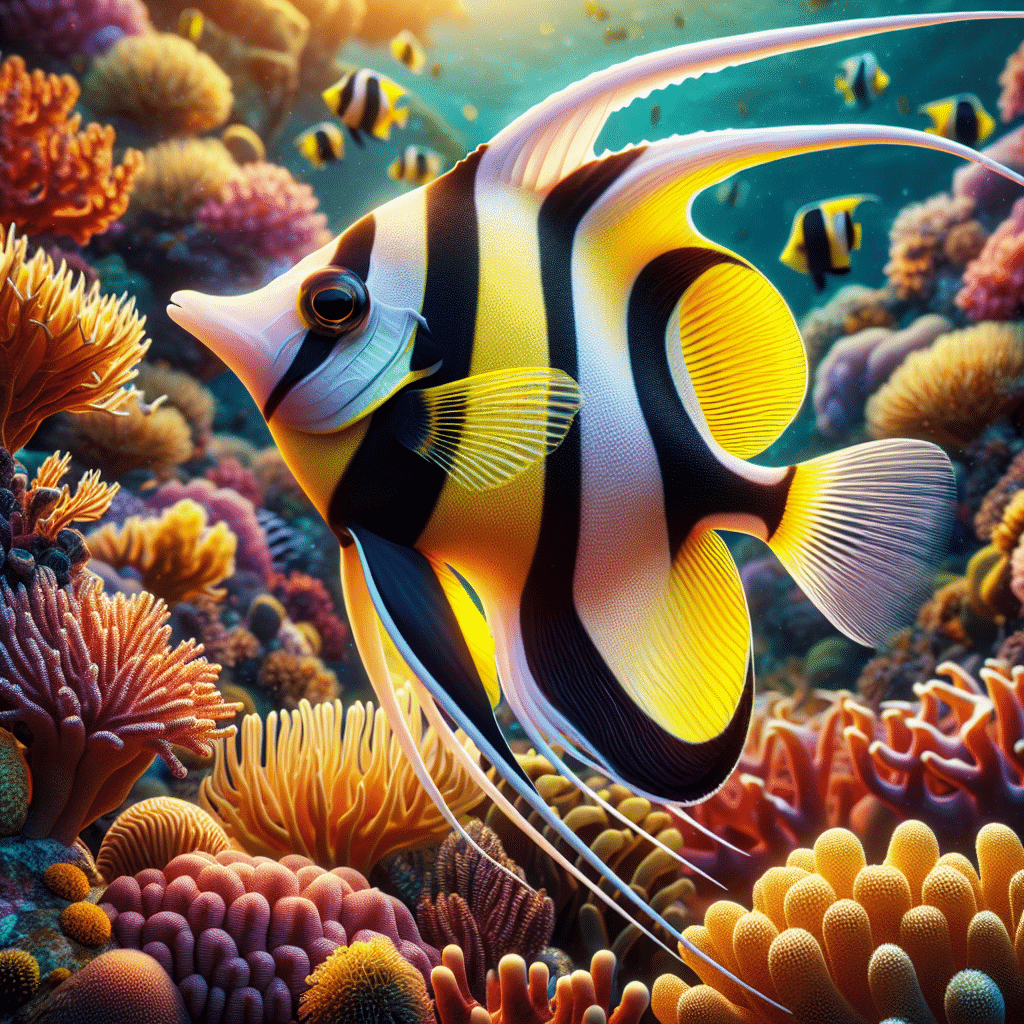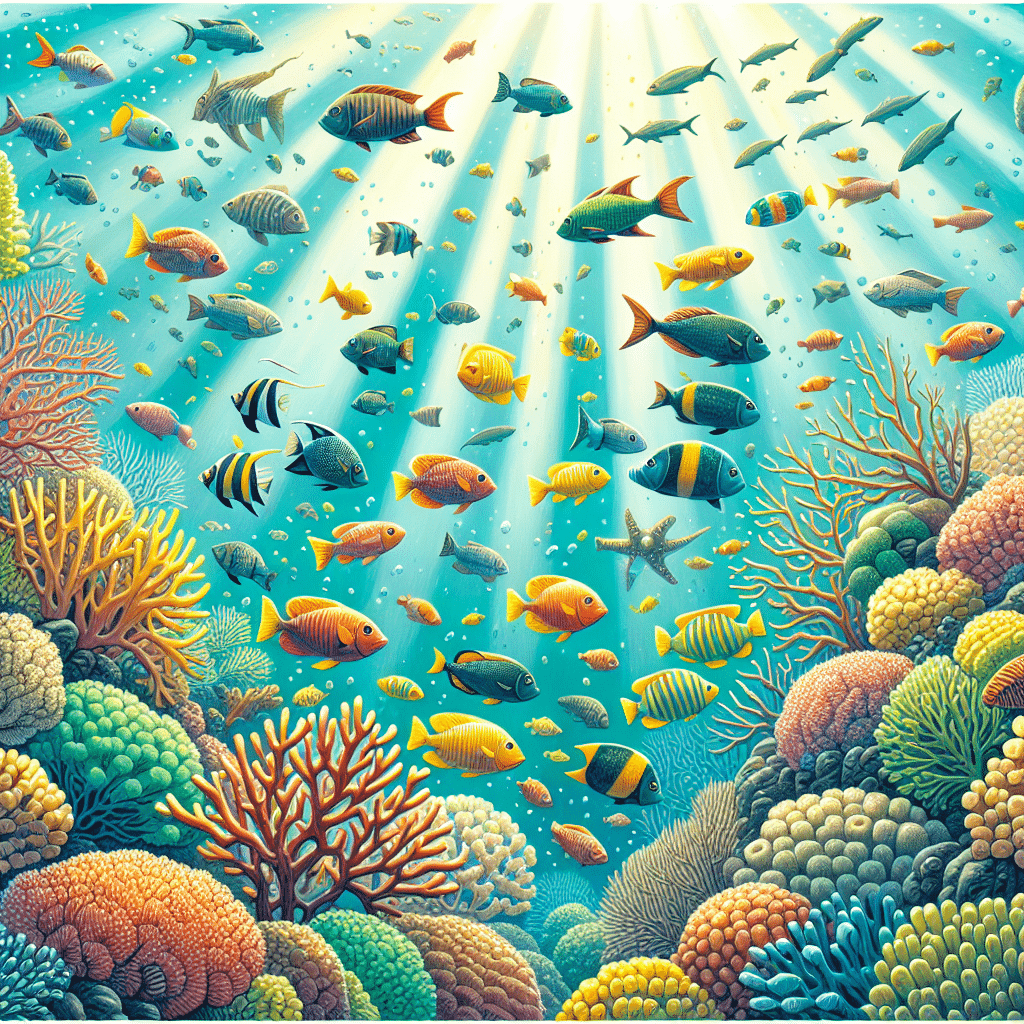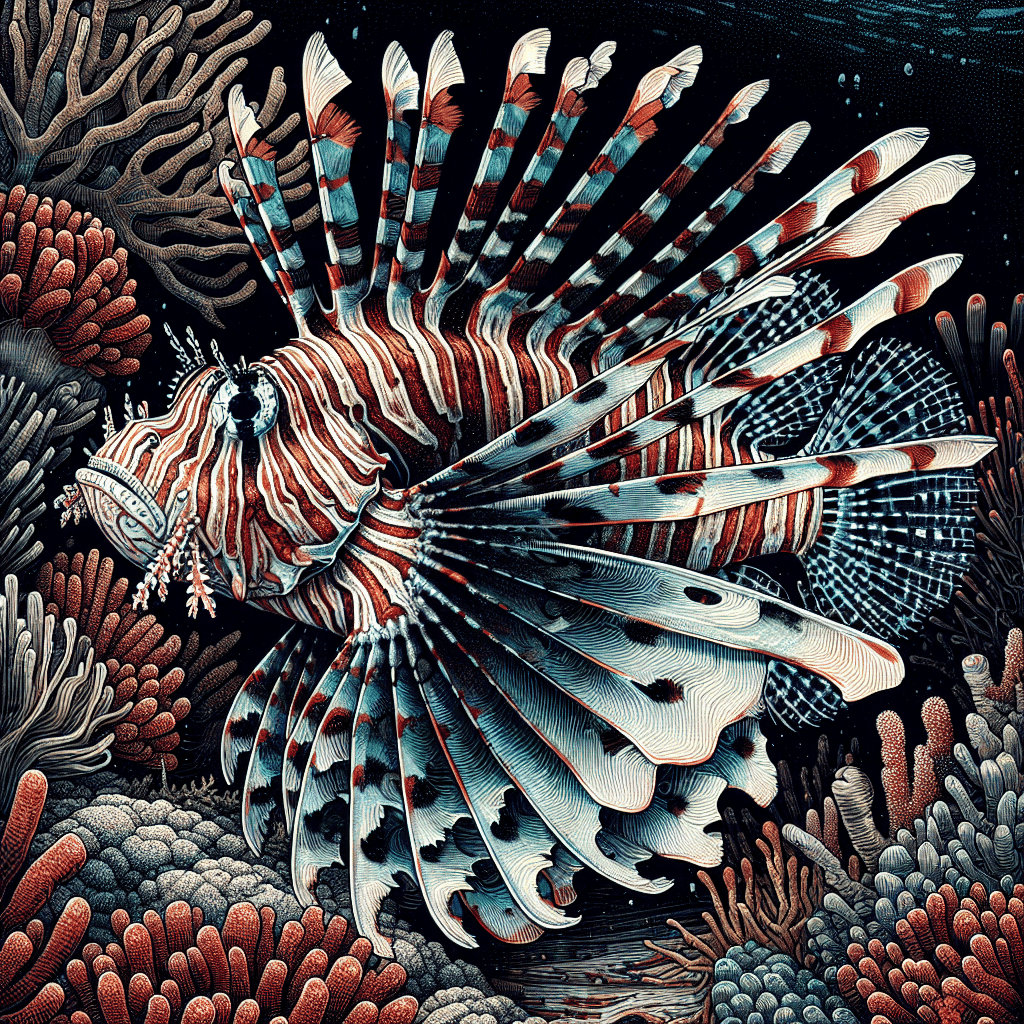Moorish Idol Overview
Introduction to the Moorish Idol
I’ve always been fascinated by the Moorish idol (Zanclus cornutus), a stunning fish that’s often found in coral reefs throughout the Indo-Pacific region. It’s the only member of its genus and is easily recognizable due to its vibrant colors and unique shape. Originally described by Carl Linnaeus in 1758, the Moorish idol has captivated fish enthusiasts and divers alike ever since Wikipedia.
This species is often mistaken for other similar fish, like the butterflyfish or bannerfish, but it has distinctive features that set it apart. With its bright yellow coloring, alternating black and white stripes, and an orange mask across its snout, the Moorish idol is a true gem of the reef.
Physical Characteristics
The physical appearance of the Moorish idol is quite unique. Its body is highly compressed and disc-like, which allows it to maneuver easily among the corals. Here are some key characteristics:
| Feature | Description |
|---|---|
| Maximum Length | 23 cm (9.1 in) |
| Typical Length | 21 cm (8.3 in) |
| Body Shape | Disc-like, highly compressed |
| Snout | Tube-like |
| Teeth | Long, bristle-like |
| Dorsal Fin | Trailing filament |
Adults have small bony protuberances above their eyes, adding to their distinctive look. The Moorish idol’s small mouth is perfectly adapted for grazing on the algae and small invertebrates that make up its diet. Its elegant fins and vibrant coloration make it a favorite among aquarium enthusiasts and a beautiful addition to any reef tank.
If you’re interested in adding this stunning fish to your collection, it’s important to understand its needs and habits. The Moorish idol can be a challenging fish to care for, which is discussed in the section about captivity challenges.
Habitat and Distribution
Natural Habitat
The Moorish idol is a fascinating fish often found in various marine environments. These little beauties are mostly spotted in tropical and subtropical regions, especially around coral reefs, lagoons, and rocky areas. They thrive in depths ranging from 3 to 182 meters (about 9.8 to 597.1 feet), making them quite versatile in their habitat choices. Whether it’s in turbid lagoons or vibrant reef flats, Moorish idols seem to enjoy the diverse underwater landscapes.
Geographic Range
The geographic range of the Moorish idol is quite impressive. They inhabit both the Indian and Pacific Oceans, stretching from the eastern coast of Africa, including areas between Somalia and South Africa, all the way to the remote islands of Hawaii and Easter Island. Their presence is also noted in the eastern Pacific, specifically from the southern Gulf of California to Peru. Notable islands within their range include the Galapagos and Cocos Islands, showcasing their adaptability across vast distances (Wikipedia).
| Region | Description |
|---|---|
| Indian Ocean | Found from Somalia to South Africa |
| Pacific Ocean | Extends to Hawaii and Easter Island |
| Eastern Pacific | Includes southern Gulf of California to Peru |
| Depth Range | 3 to 182 meters (9.8 to 597.1 feet) |
The Moorish idol is indeed a remarkable species, perfectly suited for a reef tank setup. If you’re considering adding one to your aquarium, understanding their natural habitat can help you recreate a suitable environment. For more on marine fish care, check out our articles on marine fish and related species.
Captivity Challenges
Caring for a Moorish idol in captivity can be quite the adventure, but it also comes with its fair share of challenges. Here’s what I’ve learned about maintaining these beautiful fish.
Difficulty in Maintenance
Moorish idols are notoriously tricky to keep in an aquarium. They often require large tanks, typically exceeding 100 US gallons (about 380 liters), to thrive (Animal Spot). Their survival rate in captivity is low, with many not lasting beyond a year. This can be discouraging for hobbyists like me who want to enjoy these striking fish in our tanks.
These fish are prone to various diseases, especially when stressed. Territorial behaviors can lead to conflicts among tank mates, resulting in injuries. It’s crucial to monitor their health closely and create a stable environment to minimize stress.
Tank Size Requirements
The recommended minimum tank size for Moorish idols is 200 gallons, but larger tanks are always better. Sufficient space allows for natural movement, reducing stress and the risk of injury (Chewy). Here’s a quick overview of tank size recommendations:
| Minimum Tank Size | Recommended Tank Size |
|---|---|
| 200 gallons | 380+ gallons |
Having enough room is essential for their well-being. It ensures they can exhibit natural foraging behavior and reduces territorial disputes, which are common among these fish.
Feeding Habits
Feeding Moorish idols can also be a challenge. They have specific dietary needs that require a mix of foods. A varied diet can include algae, plankton, and prepared foods designed for marine fish. Providing the right nutrition is paramount as it plays a significant role in their overall health and stress levels.
To give you a better idea, here’s a sample feeding schedule for Moorish idols:
| Feeding Time | Food Type |
|---|---|
| Morning | Algae sheets |
| Afternoon | Marine flakes or pellets |
| Evening | Frozen plankton or brine shrimp |
It’s important to not overfeed them, as this can lead to water quality issues. Regular water changes and tank maintenance are essential to keep the environment stable and healthy for these stunning fish. If you’re looking for more information on other marine species, check out our sections on marine fish and the various types available for reef tanks.
Lifespan and Behavior
Lifespan of Moorish Idols
The lifespan of Moorish Idols typically ranges from 2 to 4 years in captivity. However, it’s important to note that their survival rate in aquariums is quite low, with many not making it past their first year due to the challenges of captivity (Animal Spot). This can be attributed to their specific care requirements and stress factors.
| Lifespan (Years) | Survival Rate |
|---|---|
| 2 – 4 | Low (most do not survive beyond 1 year) |
Behavioral Traits
Moorish Idols are known for their territorial nature, exhibiting behaviors similar to those of tangs. They engage in various forms of social interaction, including nose-to-nose fights, circling, tail-swatting, and biting. In the wild, these fish are often found in pairs and can form temporary shoals to exploit different territories.
These social behaviors can make them fascinating to observe, but they also mean that careful consideration must be given to tank mates when keeping them in an aquarium. Managing their environment and reducing stress is essential for their well-being. For more information on the care of marine fish, you can check out our article on marine fish.
In summary, understanding the lifespan and behavioral traits of Moorish Idols can greatly assist in providing the right environment and care needed for these unique fish.
Captivity Tips
Caring for a Moorish idol in captivity can be quite the adventure. I’ve learned a few things along the way that can help ensure these beautiful fish thrive in a home aquarium. Here are some tips on tank setup, feeding, and health considerations.
Tank Setup Recommendations
Moorish idols need ample space to move around, so I recommend a minimum tank size of 200 gallons. However, if you can provide a larger tank (over 380 liters or 100 gallons), that’s even better. This helps prevent stress and allows for natural foraging behavior.
| Tank Size | Recommendation |
|---|---|
| Minimum | 200 gallons |
| Ideal | Over 380 liters (100 gallons) |
Make sure to include plenty of hiding spots and swimming space. Live rock and coral structures can create an environment that mimics their natural habitat, which helps them feel secure. Keep in mind that Moorish idols can be destructive, so ensure your decorations are stable.
Feeding Guidelines
Moorish idols are voracious eaters and require a varied diet. They thrive on foods like live sponge material — something I’ve found to be crucial. It’s best to train multiple specimens to feed at the same time but in different areas of the tank to reduce territorial disputes.
Here are some food options that I suggest incorporating:
| Food Type | Description |
|---|---|
| Live Sponge | Natural food source, essential for health |
| Seaweed | Provides necessary nutrients |
| High-quality Pellets | Balanced diet for everyday feeding |
| Frozen Mysis Shrimp | A good protein source |
Regular feeding helps to keep their energy up and prevents them from becoming overly aggressive toward each other.
Health Considerations
Maintaining the health of Moorish idols can be challenging. They can display territorial behaviors similar to tangs, including tail swatting and circling. It’s important to monitor their interactions to prevent injuries.
Ensure the water conditions are optimal, as Moorish idols are sensitive to changes. Regular water testing and maintenance are vital. I always keep an eye on parameters like pH, salinity, and nitrate levels.
If you’re considering alternatives or substitutes that closely resemble Moorish idols, you might want to look into butterflyfish of the genus Heniochus. They can offer a similar appearance without some of the high maintenance needs.
By following these tips, I’ve found that keeping Moorish idols can be a rewarding experience, allowing me to appreciate their beauty while ensuring their health and happiness in the tank. For more information on different marine life, don’t forget to check out our guides on other fascinating fish like clownfish and tang.
Alternatives to Moorish Idols
Finding the right fish for my reef tank can be a bit of a challenge, especially when considering alternatives to the Moorish Idol. One of the best substitutes I’ve come across is the Banner Fish.
Banner Fish as Substitutes
The Banner Fish (Heniochus spp.) is a fantastic alternative to the Moorish Idol due to its similar appearance and easier maintenance. These fish are known for their striking looks and vibrant colors, making them a great addition to any marine aquarium. They consume most types of marine aquarium fare and are considered one of the easiest fish to keep in captivity. However, it’s important to note that if kept in a reef tank, they may sometimes consume the tank’s inhabitants (About Fish Online).
| Fish Type | Similarity to Moorish Idol | Ease of Maintenance | Potential Issues |
|---|---|---|---|
| Banner Fish | High | High | May eat smaller tank inhabitants |
Considerations for Banner Fish
When considering adding Banner Fish to my tank, I need to keep a few factors in mind. The Longfin Bannerfish (Heniochus acuminatus) closely resembles the Moorish Idol and is known for its peaceful demeanor. It’s best kept in small shoals, which means having a few of them together can create a beautiful display.
The recommended water temperature for keeping Banner Fish is about 72-78 degrees Fahrenheit (23-26 degrees Celsius). This temperature range is crucial for their health and overall well-being (About Fish Online).
| Parameter | Recommended Value |
|---|---|
| Water Temperature | 72-78 °F (23-26 °C) |
| Group Size | Small Shoal (3-5) |
Keeping a Banner Fish instead of a Moorish Idol allows for a similar aesthetic while providing a more manageable care routine. Whether you’re just starting in the hobby or looking to expand your marine aquarium, Banner Fish are an excellent option to consider.
Conservation and Ethical Considerations
Wild vs. Captive Environments
I’ve always been captivated by the beauty of the Moorish idol, but it’s vital to understand the implications of keeping such a fish in captivity. These stunning creatures are notoriously difficult to maintain in an aquarium setting. They require large tanks exceeding 380 liters (100 US gallons) and are prone to diseases, especially when stressed. This makes their survival rate in captivity quite low (Animal Spot). Many aquarists find themselves in over their heads when trying to provide the appropriate care for these fish.
Since the Moorish idol thrives in its natural habitat, observing them in the wild is a more ethical option. It’s heartbreaking to think about the challenges they face in captivity. Not only do they struggle to find suitable food, but they also often succumb to stress-related ailments. It’s generally considered cruel to keep them in aquariums, which suggests that we should admire them in their natural environments instead (About Fish Online).
Conservation Efforts
Conservation efforts for the Moorish idol focus on protecting their natural habitats rather than promoting their capture for aquariums. Organizations and local governments are working to preserve coral reefs and marine ecosystems, which are crucial for the survival of many marine species, including the Moorish idol. By supporting these initiatives, I can help ensure that these beautiful fish continue to thrive in their natural environments.
Researching alternatives to the Moorish idol, such as butterflyfishes of the genus Heniochus, can also be beneficial. These species are often considered more suitable for aquarium life due to their hardiness and adaptability (Wikipedia). By promoting fish that are more likely to thrive in captivity, we can improve the overall health of our reef tanks while still appreciating the beauty of marine life.
In summary, while I admire Moorish idols for their unique beauty, I recognize the importance of conservation and ethical considerations in maintaining the health of our oceans and the fish that inhabit them. Supporting sustainable practices and choosing more suitable tank mates can make a significant difference in the world of marine aquariums.
Appreciating Moorish Idols
Observing in Natural Habitats
I absolutely love the idea of observing Moorish Idols in their natural environment. These stunning fish can be found swimming gracefully among tropical coral reefs, primarily in regions like East Africa, the Indian Ocean, Hawaii, Southern Japan, and Micronesia. They thrive in tropical and subtropical waters throughout the Pacific and Indo-Pacific regions. The sight of a Moorish Idol gliding through vibrant corals is truly a memorable experience, as they are photogenic subjects that ignite imaginations around the world of coral reefs.
Seeing these fish in the wild not only allows me to appreciate their beauty but also enhances my understanding of their natural behaviors. Observing them in their habitat reinforces the importance of preserving these ecosystems, as they play a significant role in maintaining the health of coral reefs.
Ethical Practices
It’s crucial to consider ethical practices when it comes to Moorish Idols. Given the challenges they face in captivity, including difficulties in providing appropriate food and the high likelihood of not surviving, it is considered cruel to keep them in aquariums. Instead, I believe we should admire their beauty in their natural surroundings. This way, they can flourish in their native habitats rather than struggling in captivity (About Fish Online).
In supporting ethical practices, I also encourage fellow hobbyists to prioritize the health and well-being of marine life. By taking steps to protect their natural habitats, like supporting conservation efforts and avoiding the capture of wild Moorish Idols for the aquarium trade, we can help ensure that future generations can enjoy the wonder of these incredible fish. For those interested in other marine fish, there are numerous alternatives that can thrive in a home aquarium, such as clownfish and tang.
Ultimately, appreciating Moorish Idols involves recognizing their unique beauty in the wild and making conscious choices that promote their conservation and ethical treatment.



